Samhain – All Hallows Eve
As the leaves fall all around us what else might we need to let go of?
Marie Louise Edwards
Around the end of October and the beginning of November we may celebrate and acknowledge the traditional Gaelic festival, Samhain, more recently referred to commercially as Halloween. The focus on spirits, ghosts and all things supernatural are associated with the understanding that the veil between the material and the spiritual world is thinner at this time. We find ourselves now fully inhabiting the dark half of the year. The biting cold and chilling breezes encourage us to dress warmly. We may increasingly retreat indoors to find warmth and shelter; spend our evenings by the fire; or gather with friends to celebrate, commune and play games.
Outside, the leaves have been falling in abundance and we have already greeted the funghi and fruits of autumn. We might join with our squirrel companions and gather up some of the last of the berries and nuts on our journey towards the incubation, dormancy and stillness of winter. This is a time to let go, release and reflect; reconnecting with our roots as well as our personal thoughts, ideas, visions and wishes.
As we begin to withdraw and let go with the season it might be timely to wonder about what we do have control or power over in our local communities and also in the wider world. Often, we may look to our councils, world leaders, politicians, financial institutions and the legal system to guide us through life. Yet at this stage in human development, when so many of us know that our best interests are not always willingly served by the wealthy and powerful, it may be worth contemplating what we as individuals are able to exert influence over.
We are labelled as ‘consumers’, those who take from the land, eat and use things without giving back. In permaculture circles, the emphasis on human beings becoming ‘producers’ is a powerful antidote to the ‘consumer’ lifestyle. Yet, to become effective ‘producers’ we need time. Time to recuperate from the demands of the culture that we have been living in; time to explore our inherent gifts, strengths and abilities and time to begin to plan and build the new lifestyles that we know will support our wellbeing, local communities and the needs of future generations.
Should we really expect those ‘in power’ to listen to us when they have not been doing so for so long? Or should we sing our own songs, connect with our own life force and advance in building our own dreams and ideals regardless? If we were to truly use our power and take appropriate action for the good of each other and all of life would those ‘in power’ really have so much hold over us? We spend a lot of time and energy in moaning and complaining about the state of things when really we can just take action in our own ways and see what happens.
The emergence of healthy, life sustaining developments will help demonstrate that change is possible, inevitable even, and our life enhancing ways of being will gain traction. Those who are most lost and stuck may begin to feel hope when they see what can be achieved. I like to imagine that just as the old, dysfunctional system clamps down on us in its death throes that we will have built the momentum and wherewithal to rise up together, in unity, strong in the knowledge that we have already found our way. The blueprints are here, laid out before us; many of our readers and contributors are already embracing and generating the change. I look forward to the time in which we can rejoice in our quiet, gentle yet steady shift to a healthier way of being that operates in harmony with all.
With love, thanks and gratitude at Samhain.
 |
Be ‘In-Tune’ with Nature
Krysia Soutar
Observing nature's patterns
For us who live further away from the equator, Autumn is a time of slowing down and gathering our resources as we prepare for the winter to come.
In our temperate climate we can observe how everything changes as we move from high energy of summer towards a quieter more downward energy of early autumn and then into late autumn. In nature, we can see this shift, the trees start to loose moisture, everything becomes dryer and the branches "let go" of their leaves. If we go into nature for a walk, we can feel the quiet beauty of autumn time, we can reflect on this and look back on the year and begin to think of the things we want to accomplish in the winter-time that lies ahead of us.
Nature's yearly cycle of movement and change
In permaculture, observation is important. If we have a broad understanding of this cycle of yearly change, it can assist us to plan well for all eventualities. We are then truly ‘working in tune with nature.’
Ancient civilisations had a great awareness of these cycles of change. The cycle of 5 transformations of energy, emerging from ancient chinese culture, is a detailed and deep understanding of natures cycles gained from observation. Other societies have developed a similar approach, the "four humours" of ancient Greece and the Ayerveda of the Indian sub-continent are just two of many other examples.
I like to refer to the 5 transformations and I am mindful of the greater view. We can use this knowledge and build on it to create our own expressions of how Nature works, we can see how everything is connected and that we are not separate from her.
In this system, the characteristic of early Autumn is known as Soil Energy, the organs associated with this time of year are: Spleen, Stomach and Pancreas. We can grow and harvest, sweet tasting vegetables which help support and nourish these organs. Carrots, pumpkin, squash, swede, onions, beetroot are bountiful now. A wonderful tonic is to drink the sweet juice from your cooked vegetables. This will help to keep your blood sugar stable and you can feel a nice glow!
Late Autumn
As nature's yearly cycle of energy begins to enter this phase, we observe more wonderful changes in the colour of leaves and they are now falling heavily from their branches.
Late Autumn is known as Metal Energy. The Lungs and Large Intestines are associated with this time of year. These two organs are both associated with expelling waste form the body, the Lungs expel carbon dioxide, and the Large Intestine helps to excrete solid residue from the body. If, such as happens in cooler and damper weather, the function of Lungs and Large Intestine is sluggish, waste cannot leave the body and this can cause problems for the skin, which is sometimes known as “ the third lung”. The bowels work best with regular movement. For this to happen, we need to move our bodies and keep active, walking being one of the most beneficial activities! Anything which keeps you moving and breathing deeply will be supportive for your Lungs and Large Intestine.
A diet rich in plant fibre and vegetables helps to assist the self-cleansing process of the bowel. Autumn vegetables are ideal for this. Fermented foods, in particular, support and nourish your intestinal microbes, they flourish in the correct environment and assist with smooth digestion. Research is now showing the importance of maintaining a healthy gut flora, named as our microbiome.
Taste: Sweet taste associated with early autumn, pungent taste (radish, garlic, horseradish, ginger) with late autumn.
Recipes for Autumn
Fruit and Berry Jelly using Sea-Vegetable Gelling Agent
(Suitable for vegans)
- 2 Apples
- 2 Pears
- 1 punnet of strawberries
- 1 punnet of raspberries
- 500ml pure apple juice (I used English Organic Apple Juice purchased from Village Greens Food Cooperative in Prestwich)
- 2 tbsp agar agar flakes
- a natural gelling agent
- 1 pinch sea salt.
Method
Wash and dice strawberries, add to bottom of serving dish. Wash raspberries and place into serving dish. Peel wash and dice apples and pears into chunky pieces, place into pan with covering water, bring to boil and simmer for 2 mins, remove fruit and place into serving dish Add apple juice, agar flakes and sea salt to pan, bring to a gentle boil, stirring frequently. Turn down flame to keep a low simmer for approx. 8-10 mins. Stir occasionally until flakes are fully dissolved and the liquid turns clear Pour the hot juice over fruit in the dish and allow to cool and set. You can make this ahead of time and place in the fridge to keep cool. Add whatever topping you like if you wish.
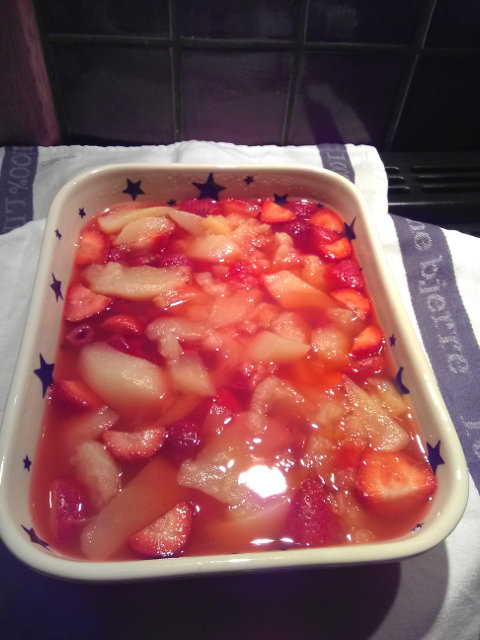 |
|---|
 |
*Agar–agar flakes are made from a type of sea "moss"(gracilaria) that is common in the Pacific ocean. They are used as an alternative to gelatin (which is a by-product from the meat industry). Our local agar-agar equivalent is carrageen, or "Irish moss" (chondrus crispus). I cannot find a quality product from this country, mine comes from Japan. Hopefully one day a local version will be readily available.
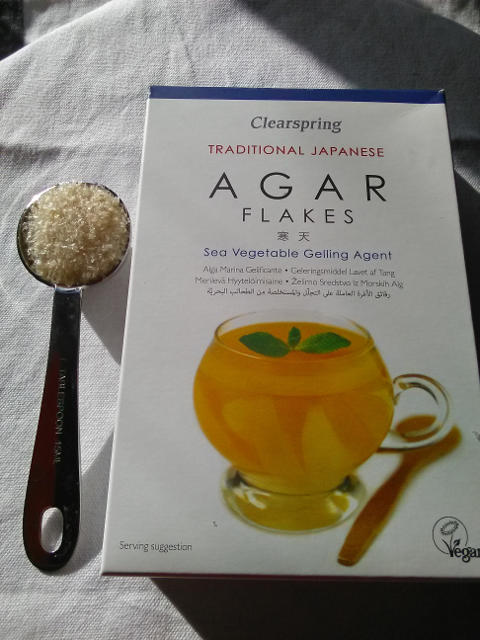 |
|---|
 |
Vegetable Soup with miso paste
Serves 4
- 1 carrot
- 1 onion
- 1 spring onion
- 500ml of water
- 5cm piece of dried wakame seaweed
- 1 dried shitake mushroom
- Barley miso (naturally fermented)
- Parsley.
 |
|---|
| Ingredients |
 |
Method
Place 500ml water into pot. Dice carrot into small pieces and add to pot. Dice onion into small pieces and add to pot. Add diced shitake mushroom. Add diced wakame. Add soaking water from wakame and shitake. Bring pot to boil and simmer for 10 mins.
Miso flavouring: use about 1 level teaspoon of miso per person. (The resulting taste should be slightly sweet, rather than salty). Add miso to a bowl and use some of the cooking water to puree it, then add to pot. Allow soup to simmer for 3 mins, do not let it boil or you will destroy the living micro–organisms in the miso.
Garnish with sliced spring onion and chopped parsley.
*To rehydrate the seaweed, rinse and soak in water until soft. Remove away any hard stem parts, cut the soft wakame into small pieces. Add soaking water to pot.
*Soak the shitake mushroom in water until soft (about 20mins), cut into small pieces, discard stem as it is too bitter. Add soaking water to pot.
Wakame : A delicate member of the kelp family. Requires short soaking and cooking time. Has a mild flavour.
Miso: Made from fermented soya beans. Traditionally aged for2 years. Rich in digestive enzymes, helps to strengthen the digestive system.
Shitake mushrooms: Known to help in lowering cholesterol and triglycerides and for cleansing blood.
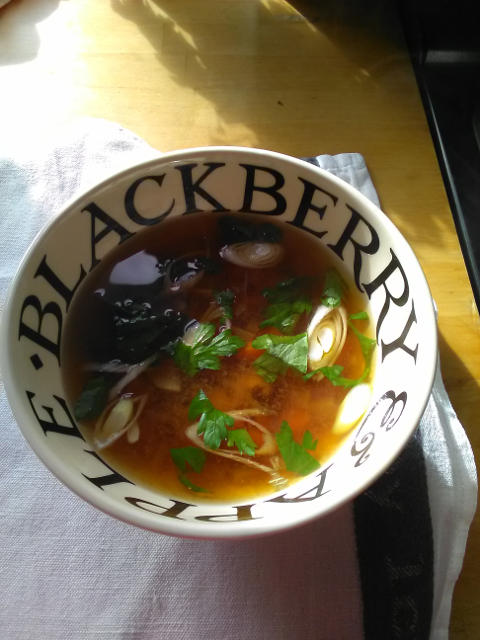 |
|---|
| Vegetable miso soup |
 |
Medicine for late autumn
Edwina Hodkinson BSc(Hons) MNIMH Medical Herbalist
The nights darken, the weather cools and the energy of nature goes back into the soil. Despite the falling leaves, Berries can still be found on the small trees and frost-softened rosehips are often in adundance, bringing colour to the almost bare hedgerows and nourishment into the kitchen. For millennia our ancestors have worked in close attunement to the land, knowing that the medicines that are seasonally produced by nature are what our bodies need the most for survival at that time of the year, with Elderberries, Haws and Rosehips providing high levels of vitamin C and anti-oxidants. Elderberry is a powerful anti-viral medicine that’s great for winter viruses; Hawthorn, as well as being an amazing heart tonic, also supports arthritic joints; and some of the root medicines such as elecampane and marshmallow are excellent for coughs.
Rosehips – Rosa canina
Rosehips are easily identifiable, abundant and widespread. Once the red hips are softened to ripeness by the first frosts and they are soft and squashy when squeezed between the finger and thumb, they can be used in food and medicine. For the times when the frost is late in coming it's just as good to put a bagful in the freezer to soften before using them in medicines.
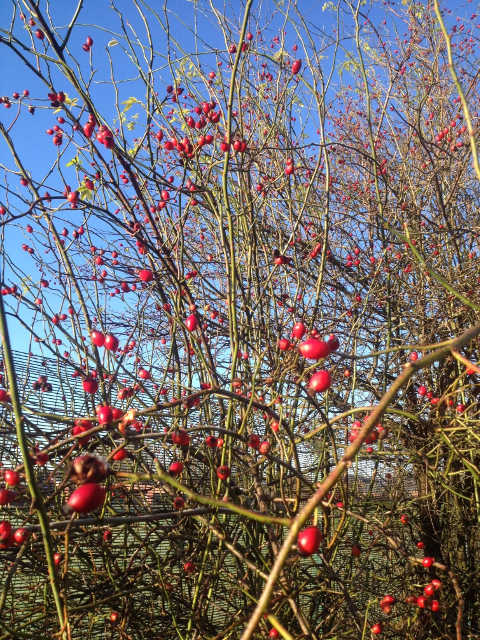 |
Rosehips are rich in Vitamins C, A, B and K. |
For those over a certain age, there are comforting memories of sweet rosehip syrup and stories shared of schoolchildren, in the years during and after the war, collecting rosehips to make rosehip syrup to be given to children and pregnant women at a time when oranges and other citrus fruits were hard to come by. Rosehips have 20-40 times more Vitamin C than oranges and are also rich in Vitamins A, B and K. They contain powerful anti-oxidants and make an excellent immune booster, being extremely useful in preventing and fighting infections, colds, flu, and pneumonia. Rosehips are also prized for their anti inflammatory uses and helpful with winter aches and pains.
Rosehips are easy to find, and all species can be used. The important thing to remember is that whatever you make with them it’s important to get rid of the fine hairs inside which are very irritating to the digestive tract and are used by schoolchildren as itching powder. This can be done by passing any liquid through a fine muslin cloth before use. There are many recipes online to make rosehip syrup and it's good fun and nostalgic to make the wartime recipe. However, not everyone wants to use sugar in a recipe, so the rosehips can be made into an Oxymel with vinegar and local honey.
Rosehip Oxymel
- Take a couple of pounds of rosehips softened by frost and rinse.
- Chop by hand or in a food processor.
- Pack into a jar. Cover with half raw cider vinegar and half honey, seal and leave to infuse in a cool place for a month.
- Strain through a sterilised muslin and sieve.
- Bottle and label.
Keep in a cool, dark place. Use within 6 months of opening. Take 5-10 ml each day in a little warm water for an immune-boosting, anti-inflammatory effect.
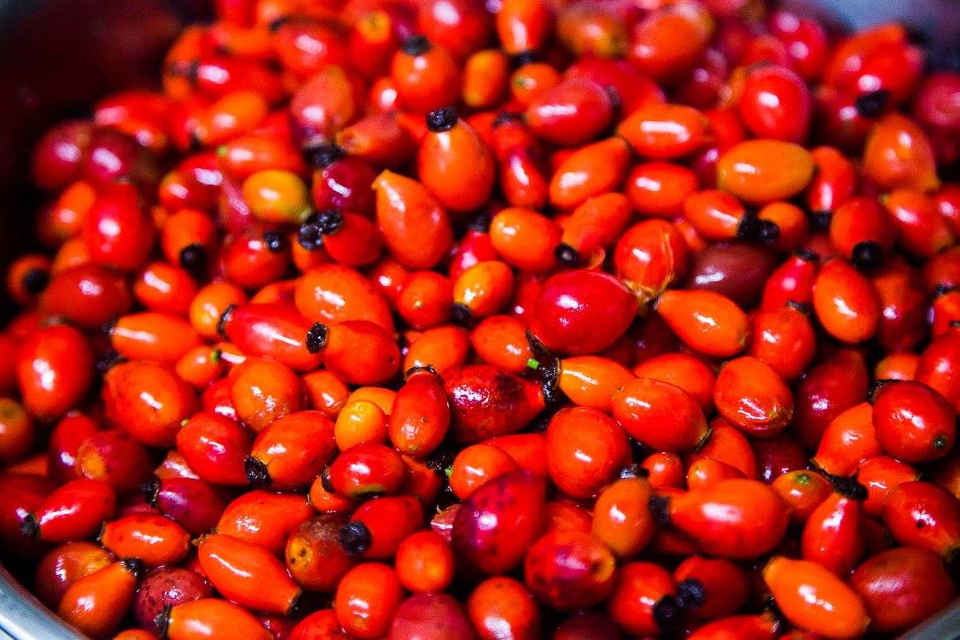 |
| from Weeds and Wild Medicine |
 |